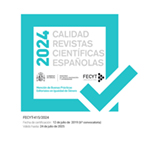Open Peer Review Vol.21 N.1
Forms of Rage in Franco's Spain
Lisa DiGiovanni
Section: Videoessay
Editorial Recommendations:
Your submission has been accepted for publication, pending some minor revisions to the written statement. Your video essay analysis illuminates how the film serves as a powerful mirror to a world marked by political oppression, economic disparities, and virulent homophobia. It vividly illustrates how the children in this harsh environment are taught that violence is not an exception but rather a tool. Through a meticulous examination of the film, the video essay probes the intricate dynamics of rage, showing how it can either fuel the transcendence of heteropatriarchal norms or inadvertently reinforce them. The video essay compellingly argues that the film exposes the manipulation of marginalized individuals' rage by those in positions of power, shifting blame and maintaining their control. Furthermore, it skillfully dissects how, when rage is fueled by shame and fear, it loses its potential for productive change, becoming instead a destructive force. Ultimately, the video essay highlights the film's poignant portrayal of the protagonist's struggle to reclaim his identity from the clutches of fear and rage, leaving viewers with a thought-provoking perspective on the complexity of this emotion and its role in societal change. While the videoessay is strong as it is, we would like you to consider making the theoretical framework of your written statement stronger. For instance, how does your argument differ from Audre Lorde’s “On the Uses of Anger,” or from Brittney Coopers' book, Eloquent Rage? You might also find useful to see some works on queer rage: Halberstam, J. (1993). “Imagined Violence/Queer Violence: Representation, Rage, and Resistance”, Social Text, 37 (Winter), pp. 187-201. Also it would be useful if you could see the first part of Maseda García, R., Gámez Fuentes, M.J. y Gómez Nicolau, E. (2022). White anger, Black anger: The politics of female rage in Little Fires Everywhere (HULU, 2020). IC: Revista Científica de Información y Comunicación, 19, 295-320.
Reviewer A:
Please, comment on the most relevant aspects (positive points and areas to improve) of the reviewed article.
No open comments
Would you suggest any changes or make any recommendations to improve the quality of the article?
No open comments
Reviewer B:
Please, comment on the most relevant aspects (positive points and areas to improve) of the reviewed article.
No open comments
Would you suggest any changes or make any recommendations to improve the quality of the article?
No open comments
The text included some modifications before publication












